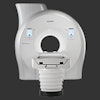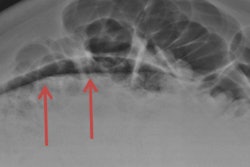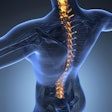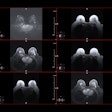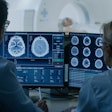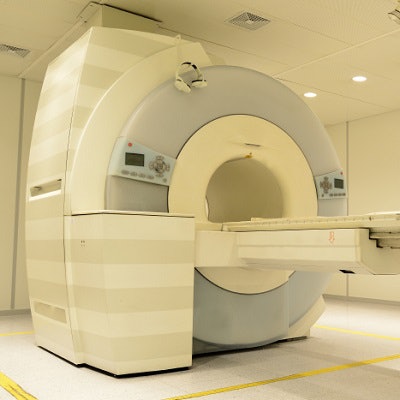
If MRI scans are running behind schedule on a given day, chances are good that patient-related issues are to blame. More specifically, patient motion, claustrophobia, and late arrivals are the most common reasons, according to a March 26 article in the Journal of the American College of Radiology.
Out of more than 34,000 MRI scans at nine imaging centers operated by Emory University, nearly 17% of the exams were delayed. After excluding delays related to contrast administration, the researchers found that 53% of delays were related to patient motion, 31% were due to claustrophobia, and 19% were due to late arrivals.
 Dr. Gelareh Sadigh from Emory University.
Dr. Gelareh Sadigh from Emory University.With the results in hand, Emory has already begun to implement strategies to rectify the problems.
"The main objective for us was to explore the unanticipated events and the magnitude of difference in the various [Emory] centers for different patients on different days of the week," said lead author Dr. Gelareh Sadigh, a radiology resident at Emory University. "Given our sample size, this study can also serve as a benchmark for other physicians to look at their own rates and compare them to ours to improve any areas."
Scanning challenges
Back in 2015, the Joint Commission released diagnostic imaging requirements for MRI safety that asked imaging facilities to track patient anxiety, claustrophobia, and the presence of metal and other foreign objects, to name a few factors, to improve the efficiency of imaging centers.
While there is considerable research on patient issues such as claustrophobia, motion, contrast reactions, and similar types of MRI delays, no benchmarks are available for other unanticipated events that may occur before and during MRI exams that can affect patient safety and quality of care, the authors noted.
"Data on the type and prevalence of a wide range of unanticipated events associated with MRI examinations in a large population, the clinical settings, and the time of day would increase awareness among radiology practices and provide opportunities for MRI practice quality improvement," Sadigh and colleagues wrote (JACR, March 26, 2017).
The researchers reviewed 34,587 MRI exams performed between June 2013 and November 2014 on 14 scanners at Emory's university-affiliated sites (30,005 scans, 87%) and three scanners at community-based outpatient imaging centers (4,582 scans, 13%).
Ten MRI systems used exclusively for outpatient imaging performed 20,124 scans (58%), while seven systems used for both outpatient and inpatient services performed 14,463 scans (42%). The vast majority of scans (31,459, 91%) were performed during weekdays, while only 3,128 scans (9%) were done on weekends and holidays.
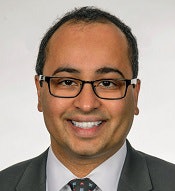 Dr. Amit Saindane from Emory University.
Dr. Amit Saindane from Emory University.As a side note, before Emory created its current electronic database, MRI technologists recorded the reasons for scan delays in a paper logbook. This rather antiquated record-keeping process was another reason why Emory researchers conducted this study.
"The lines were impossible to track, [and it was] impossible to know whether people were actually entering information correctly," said study co-author Dr. Amit Saindane, director of the division of neuroradiology at Emory. "Because of that, we really had no idea what the actual [delay] rates were for problems in each of our scanners. The motivation was to take the logs and convert them into electronic information where we could make some changes based on information we thought was more reliable and more easily tracked."
Scanning speed bumps
The researchers divided unanticipated events into six categories:
- Problems with orders and scheduling events, which resulted in cancellation or delays
- Scan delays due to late patient arrivals, patient transportation, or radiology department delays
- Unanticipated foreign objects such as metal or non-MRI-conditional pacemakers
- Contrast-related events, including patient refusal of IV contrast despite the order
- Patient-related events such as motion, claustrophobia, anxiety, or discomfort
- Technical image acquisition issues including inadequate breath-holds, contrast bolus timing, and/or mechanical scanner failure
In reviewing the records, 5,775 unanticipated events (16.7%) were discovered over the 17-month study period, with 657 patients (2%) experiencing more than one unanticipated event. University-affiliated sites reported more unanticipated events (5,538, 96%) than community-based facilities (237 events, 4%), a result that was not totally unexpected.
"Part of our hypothesis was that patients in an academic setting perhaps may be sicker, [so] there may be more people involved in their care," Saindane said. "Because of that complexity, there may be a higher rate of unanticipated events, but we really did not have an idea of the magnitude of that effect."
By far, patient motion was the most frequent cause (1,910 events, 5.5% of total scans, 53.1% of noncontrast delays), followed by claustrophobia (1,127 events, 3.3% of total scans, 31.3% of noncontrast delays) and patients arriving late for their appointments (695 events, 2% of total scans, 19.3% of noncontrast delays).
| Unanticipated events in MRI scans | ||
| Percent of total scans (n = 34,587) | ||
| Total exams with unanticipated events | 5,775 | 16.7% |
| No. of patient events related to contrast | 465 | 1.3% |
| No. of patient events unrelated to contrast | 3,597 | 10.4% |
| Reasons for noncontrast events | ||
| No. of unanticipated events | Percent of events unrelated to contrast (n = 3,597) | |
| Patient motion | 1,910 | 53.1% |
| Claustrophobia | 1,127 | 31.3% |
| Late patient arrival | 695 | 19.3% |
| Patient discomfort | 501 | 13.9% |
| Need for sedation | 429 | 11.9% |
| Radiology department delay | 311 | 8.6% |
| Breath-hold issues | 284 | 7.9% |
| Lack of IV access | 242 | 6.7% |
| Improper study protocol | 184 | 5.1% |
"With many of these numbers, we had no idea what the results would be. We really did not know that about 5.5% of the scans had a degree of patient motion," Saindane said. "That is something that we have some control over. In one way it was reassuring that it was not higher, but we now know specifically which sites were dealing with the most patient motion."
Naturally, the key is to turn a negative situation into a positive result. To remedy its patient motion issue, Emory purchased and started using head immobilizers. The number of unanticipated events related to patient motion on MRI brain scans already has decreased, according to the researchers.
"We also worked on screening forms to make sure that all patients are screened correctly for a variety of things that are contraindicated for MRI scans," added Saindane, who also serves as chair of Emory's MRI quality and safety committee.
Weekend events
While there were more unanticipated events during weekdays (5,102 events) than on weekends and holidays (673 events), the delays happened more frequently during weekends and holidays (21.5%) than on weekdays (16.2%). The researchers speculated that lower staffing levels on weekends and holidays could be one reason for the results.
"That is a future project to see if the number of staff makes a difference in the numbers," Sadigh said. "Other reasons may be due to the referring physician on the weekend who may or may not be submitting a correct order, or perhaps miscommunication with nurses on weekends."
Given that the study counted reported events, the researchers cautioned that lower staff levels on weekends and holidays could lead to underreporting of scan delays.
"The fact that we see a higher rate of unanticipated events on the weekends, my guess is that it is probably an underestimate," Saindane said. "So we do want to look much more carefully at that particular issue because it may be related to the level of staffing or related to a variety of other factors [such as] orders and ordering teams."
The Emory researchers also plan to delve deeper into the numbers on a site-by-site basis to see which facilities have higher incidences of unanticipated events and why.
"We now want to go about implementing some concrete changes based on the outliers, whether they are related to screening, motion, or other factors, to see if we can impact these numbers further down the line," Saindane said. "Hopefully, these [results] are representative, so if another institution or practice wants to try this themselves and see where they stand, they have a benchmark."

